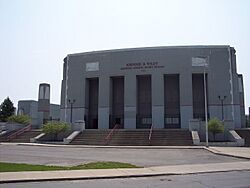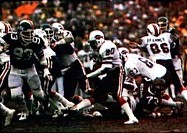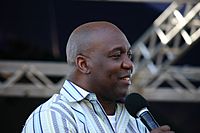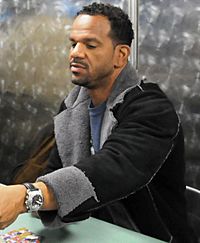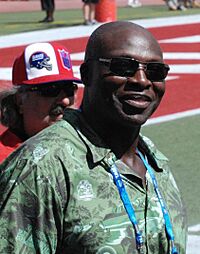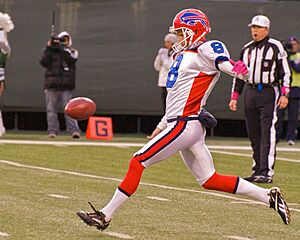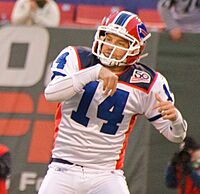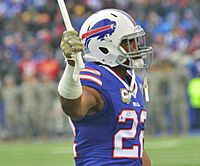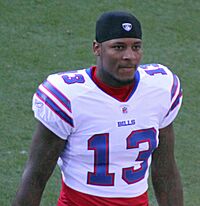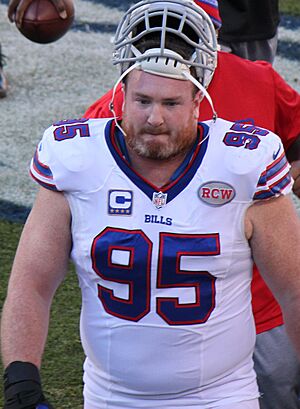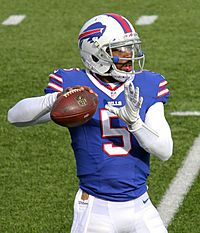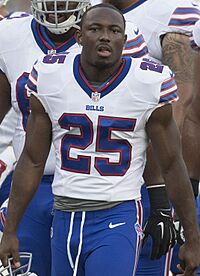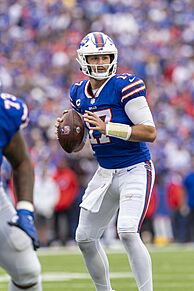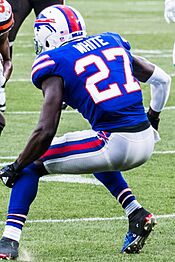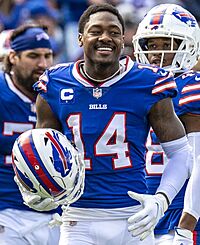History of the Buffalo Bills facts for kids
The history of the Buffalo Bills began in 1960. That's when the team started playing as a founding member of the American Football League (AFL). They quickly won two AFL titles in a row in 1964 and 1965. The Bills then joined the National Football League (NFL) in 1970 as part of the AFL-NFL merger.
The Bills are famous for being the only team to reach four straight Super Bowls from 1990 to 1993. However, they also lost all four of those championship games. This team was the second professional football team to represent Buffalo, New York. Ralph Wilson founded the Bills and owned them from the start until he passed away in 2014. Later that year, his family sold the team to Terrence Pegula and his wife Kim.
Contents
Early Football in Buffalo
Long before the current Buffalo Bills, professional football was played in Buffalo and western New York. Teams like the "Buffalo All-Americans" joined what would become the NFL in 1920. Later, in 1947, a team in the All-America Football Conference (AAFC) was named the "Buffalo Bills." This name came from a popular barbershop quartet, which was a play on the famous Wild West showman Buffalo Bill Cody. Even though this AAFC team later merged into the Cleveland Browns and isn't directly connected to today's Bills, the name was so popular that it was used again for the new AFL team in 1959.
Bringing Pro Football Back (1960-1985)
Starting the AFL Team
In 1959, when Lamar Hunt announced the creation of the American Football League, Buffalo was one of the cities he wanted a team in. Ralph Wilson, who owned a small part of the Detroit Lions NFL team, agreed to start a team in the new AFL. He told Hunt, "Count me in. I'll take a franchise anywhere you suggest."
Wilson first wanted a team in Miami. But officials there were worried because a previous football league had failed. So, they wouldn't let an AFL team play in the Miami Orange Bowl. Wilson then looked at Buffalo. A friend from his military days, George E. Schaaf, told him there was a lot of interest in football in Buffalo. Key people in Buffalo, including Pat McGroder, helped Wilson get a good deal to play at Civic Stadium. This stadium was mostly for auto racing but was the only place big enough. Wilson removed the racetrack and turned it into a stadium for both baseball and football. He then sent a famous message to Hunt: "Count me in with Buffalo."
Other cities Wilson considered later got their own pro football teams. For example, the Miami Dolphins joined the AFL in 1966, and the Atlanta Falcons joined the NFL in 1967.
Early AFL Years (1960-1963)
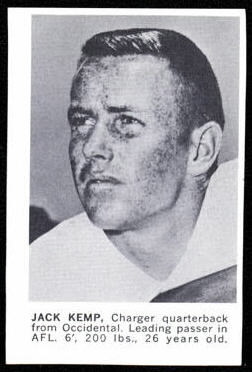
The Buffalo Bills started as a founding member of the AFL in 1960. After a public contest, they chose the same name as the old AAFC team. In their first season, the Bills finished 5–8–1. They then got some top draft picks in 1961, including offensive tackle Ken Rice and guard Billy Shaw.
In 1961, the Bills played a unique game against a Canadian Football League team, the Hamilton Tiger-Cats. The Tiger-Cats won 38–21, making the Bills the only current NFL team to have lost to a CFL team.
Before the 1962 season, the Bills added players who would help them succeed. They got quarterback Jack Kemp from the San Diego Chargers. The Chargers thought Kemp had a bad hand, but he would lead Buffalo to championships. The Bills also drafted college star Ernie Davis. Sadly, Davis passed away before he could play professionally. Instead, the Bills signed Cookie Gilchrist, a top running back from the CFL.
Championship Years (1963-1966)
From 1963 to 1966, the Bills had their first great period. They made the playoffs every year and won back-to-back AFL championships in 1964 and 1965. These teams were led by coach Lou Saban and later Joe Collier.
The 1964 team had a 12–2 record. They beat the defending AFL champion San Diego Chargers 20–7 in Buffalo. A famous moment in that game was linebacker Mike Stratton's hard hit on Chargers' star Keith Lincoln. This hit, known as the "hit heard 'round the world," changed the energy of the game. The Bills' defense was incredibly strong, not allowing a rushing touchdown for 16 straight regular season games.
In 1965, the Bills' offense faced challenges due to injuries and trades. But their amazing defense and a short passing game led them to a 10–3–1 record. They faced the Chargers again in the championship game. This time, the Bills shut out San Diego 23–0 on the Chargers' home field. Buffalo cornerback Butch Byrd scored a 74-yard punt return touchdown.
A big event that helped lead to the AFL–NFL merger involved Bills kicker Pete Gogolak. He was the first to kick "soccer style." After the 1965 season, the NFL's New York Giants signed him away from the AFL. This started a bidding war for players between the two leagues. This competition eventually led to the AFL and NFL joining forces in 1970.
Many fans from that time believe players like Mike Stratton, Butch Byrd, Tom Sestak, and Ron McDole should be in the Pro Football Hall of Fame. Only offensive guard Billy Shaw from those championship teams is in the Hall of Fame.
In 1966, coach Saban left, and Joe Collier became head coach. The New York Jets and their young quarterback Joe Namath were becoming strong rivals. The Bills won their third straight division title, but lost the AFL Championship game to the Kansas City Chiefs 31–7. The Chiefs then played in the very first Super Bowl.
Tough Times (1967-1971)
After 1966, the Bills struggled to keep a championship-level team. Injuries hurt the team in 1967, and they finished 4–9–1. The 1968 season was even worse, with a 1–12–1 record. This gave the Bills the first pick in the 1969 AFL-NFL draft, which they used to select O. J. Simpson.
Offensive lineman Bob Kalsu left the team after his rookie season to serve in the Vietnam War. Sadly, he died while serving in 1970.
Even though the Bills struggled, some players brought excitement. These included O. J. Simpson, quarterback Dennis Shaw, and wide receivers Haven Moses and Marlin Briscoe. In 1969, the Bills also drafted James "Shack" Harris, who became a starting quarterback and helped break racial barriers at the position.
The "Electric Company" Era (1972-1977)
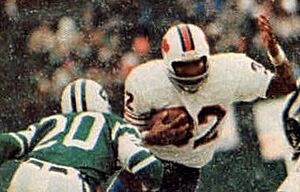
Before the 1969 season, the Bills drafted running back O. J. Simpson, who became the face of the team in the 1970s. After the NFL-AFL merger, Buffalo was placed in the AFC East division. Their first NFL season in 1970 saw them win only three games. In 1971, the Bills had the worst record in the NFL at 1–13.
Lou Saban, who had coached the Bills' AFL championship teams, was rehired in 1972. Meanwhile, War Memorial Stadium needed to be replaced. It was in bad shape and too small for NFL rules. Owner Ralph Wilson threatened to move the team if a new stadium wasn't built. Local leaders agreed, and construction began on a new stadium in the suburbs. Rich Stadium (now Highmark Stadium) opened in 1973 and is still the Bills' home today.
The 1973 season was a turning point. Joe Ferguson became the new quarterback. Simpson had an amazing season, rushing for over 2,000 yards and being named NFL MVP. The Bills had their first winning record since 1966. The "Electric Company" was the nickname for the powerful offensive line that helped Simpson succeed. In 1974, the team made the NFL playoffs for the first time, but lost to the Pittsburgh Steelers.
After an 8–6 season in 1975, the Bills had problems in 1976. They finished 2–12. In 1977, Simpson was traded to the San Francisco 49ers.
The Chuck Knox-Kay Stephenson Era (1978-1983)
In 1980, the Bills had a strong season, finishing 11–5 and winning their first AFC East title. However, they lost in the playoffs to the San Diego Chargers. In 1981, the Bills made the playoffs again as a wild-card team. They beat the New York Jets in the first round but lost to the Cincinnati Bengals in the next.
In the famous 1983 draft, the Bills picked quarterback Jim Kelly. But Kelly chose to play in a new league called the United States Football League instead.
Near Collapse (1984-1985)
Coach Chuck Knox left, and running back Joe Cribbs also went to the USFL. The Bills had very bad seasons in 1984 and 1985, winning only two games each year. Attendance at Rich Stadium dropped, and the team's future in Buffalo seemed uncertain. Owner Ralph Wilson even received offers to move the team. Player Steve Tasker later said that joining the Bills at that time felt like a punishment because of their poor record and Buffalo's weather.
Becoming a Top Team (1986-2000)
New Leaders Arrive (1986-1989)
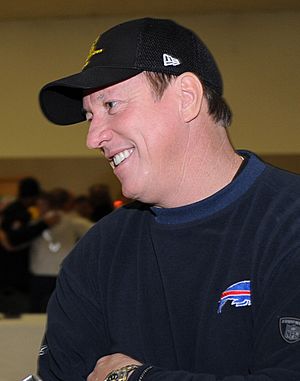
When the USFL league ended in 1986, the Bills gained many talented people. These included general manager Bill Polian, head coach Marv Levy, and quarterback Jim Kelly. Kelly, along with players like wide receiver Andre Reed, defensive end Bruce Smith, and center Kent Hull, helped build a strong team.
After a strike-shortened season in 1987, the Bills had a great year in 1988. With rookie running back Thurman Thomas, they went 12–4 and won the AFC East title. They won their first playoff game but lost the AFC Championship to the Cincinnati Bengals.
The 1989 season was a bit disappointing, with a 9–7 record and a playoff loss. The team was even called the "Bickering Bills" because of arguments among players and coaches.
The Super Bowl Years (1990-1993)
In 1990, the Bills started using a fast, no-huddle offense called the "K-gun." This made their offense one of the best in the league. They finished 13–3 and easily won their playoff games to reach Super Bowl XXV. The Bills were favored to win against the New York Giants. But the Giants' defense played a great game. With seconds left, Bills kicker Scott Norwood tried a 47-yard field goal to win. His kick went wide right, and the Bills lost 20–19.
The Bills won their fourth straight AFC East title in 1991, again finishing 13–3. Thurman Thomas won the NFL MVP award. In the playoffs, they beat the Kansas City Chiefs and Denver Broncos to reach Super Bowl XXVI. They played the Washington Redskins, who took a big lead and won 37–24.
In 1992, the Bills lost the AFC East title. Quarterback Jim Kelly was injured before the playoffs. Backup quarterback Frank Reich started their first playoff game against the Houston Oilers. The Bills were down 35–3 in the third quarter. In what became known as The Comeback, the Bills made an amazing rally, winning 41–38 in overtime. This was the biggest comeback in NFL history at the time. Buffalo then won two more playoff games to reach their third straight Super Bowl, Super Bowl XXVII, against the Dallas Cowboys. The Cowboys dominated, winning 52–17. The Bills became the first team to lose three Super Bowls in a row. A highlight for the Bills was Don Beebe chasing down Leon Lett and knocking the ball out of his hands before he could score.
The Bills won the AFC East again in 1993. They won two more playoff games, setting up a rematch with the Dallas Cowboys in Super Bowl XXVIII. The Bills became the only team to play in four straight Super Bowls. They led at halftime, hoping to finally win one. But a fumble by Thurman Thomas led to a Cowboys touchdown, and the Cowboys took over the game. The Bills lost again, 30–13.
Decline and Changes (1994-1997)
Losing four Super Bowls in a row led to many jokes about the Bills. The team's reputation suffered. In 1994, the Bills finished 7–9 and missed the playoffs.
In 1995, the Bills signed linebacker Bryce Paup. They made the playoffs with a 10–6 record and won their first game. But they lost to the Pittsburgh Steelers in the next round.
In 1996, the Bills made the playoffs as a wild card team. They lost their first home playoff game ever to the Jacksonville Jaguars. After the season, Jim Kelly retired. Coach Marv Levy also retired after the 1997 season, which saw the Bills finish 6–10. This marked the end of the Bills' most successful era.
New Faces and Controversy (1998-2000)
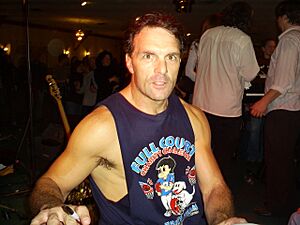
Under new coach Wade Phillips, the Bills signed two quarterbacks in 1998: Rob Johnson and Doug Flutie. Many fans wanted Flutie to start, but Phillips chose Johnson. The Bills started 0–3. When Johnson got injured, Flutie took over and led the Bills to a playoff spot with a 10–6 record. They lost their first playoff game to the Miami Dolphins.
Flutie remained popular in 1999, as the Bills finished 11–5. But Coach Phillips chose Rob Johnson to start the playoff game against the Tennessee Titans. The Bills scored a field goal to lead 16–15 with 16 seconds left. However, the Titans won on a controversial play known as the "Music City Miracle." During the kickoff, Frank Wycheck lateraled the ball to Kevin Dyson, who scored the winning touchdown. The pass was very close to being an illegal forward lateral, but the call stood. The Titans went on to the Super Bowl.
The Titans game was the Bills' last playoff appearance for 18 years. After the 1999 season, key players from the Super Bowl years like Thurman Thomas, Andre Reed, and Bruce Smith were released. In 2000, the team missed the playoffs with an 8–8 record.
After the 2000 season, general manager John Butler left for the San Diego Chargers, taking Flutie and other players with him.
Long Playoff Drought (2001-2016)
New Management and Quarterbacks (2001-2005)
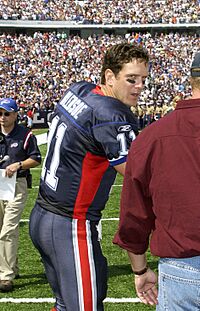
In 2001, Tom Donahoe became the new president of the Bills. He made many changes, releasing experienced players and bringing in younger ones. The team struggled, finishing 3–13 in 2001.
Before the 2002 season, the Bills traded for quarterback Drew Bledsoe, who had been replaced by Tom Brady on the Patriots. Bledsoe helped the Bills improve to an 8–8 record in 2002. In 2003, the Bills started strong but then struggled, finishing 6–10.
Mike Mularkey became head coach in 2004. The Bills also drafted quarterback J. P. Losman. Bledsoe struggled early in 2004, but the team improved later in the season, winning 9 of their last 11 games. They narrowly missed the playoffs.
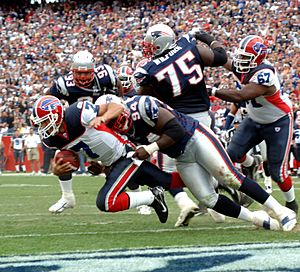
After 2004, the Bills decided to make Losman their starting quarterback. Bledsoe was released and signed with the Dallas Cowboys. Losman's development was slow. The Bills finished 5–11 in 2005. General Manager Tom Donahoe and Coach Mike Mularkey both left the team.
Marv Levy Returns (2006-2009)
Marv Levy returned as general manager in 2006, and Dick Jauron was hired as head coach. The Bills finished 7–9 in both 2006 and 2007. In 2007, they drafted quarterback Trent Edwards and running back Marshawn Lynch. Levy retired again at the end of 2007.
In 2008, the Bills started strong with a 5–1 record. But Edwards suffered a concussion, and the team finished 7–9 again.
In 2009, the Bills signed veteran wide receiver Terrell Owens. The team started 3–6, and Coach Jauron was fired. The Bills missed the playoffs for the tenth straight season. Quarterback Trent Edwards struggled with injuries, and Ryan Fitzpatrick played some games. Running back Marshawn Lynch was suspended, but Fred Jackson played well in his place. Rookie safety Jarius Byrd led the NFL in interceptions.
New Coaches and Quarterbacks (2010-2012)
Buddy Nix became general manager in 2009, and Chan Gailey was named head coach in 2010. The Bills released Terrell Owens. After starting 0–4 in 2010, the Bills released Trent Edwards, and Ryan Fitzpatrick became the starting quarterback. The team finished 4–12.
In 2011, the Bills started very well with a 5–2 record. They even ended a 15-game losing streak to the New England Patriots with a 34–31 win. However, a wave of injuries led to a 7-game losing streak, and the Bills missed the playoffs for the twelfth straight year. At this point, the Bills had the longest playoff drought in the NFL.
In 2012, the Bills signed defensive end Mario Williams to a huge contract. But the team still finished 6–10. After the season, Chan Gailey and his coaching staff were fired.
Doug Marrone and Ralph Wilson's Passing (2013-2014)
In 2013, Doug Marrone was hired as the new head coach. Doug Whaley became the general manager. The Bills released Ryan Fitzpatrick and drafted quarterback E. J. Manuel. They also added edge rusher Jerry Hughes, who, with Mario Williams, Kyle Williams, and Marcell Dareus, formed a strong defensive line known as the "Cold Front." The Bills finished 6–10 again and missed the playoffs for the 14th straight season.
Owner Ralph Wilson passed away on March 25, 2014, at age 95. His family sold the team to Buffalo Sabres owner Terrence Pegula and his wife Kim for $1.4 billion. The Pegulas promised to keep the Bills in Buffalo. They also ended the "Bills Toronto Series," where the team played games in Toronto.
The Bills finished the 2014 season with a 9–7 record, ending a streak of nine losing seasons. However, they still missed the playoffs for the 15th straight season. Quarterback Kyle Orton started most of the season but retired after it ended.
Rex Ryan and New Ownership (2015-2016)
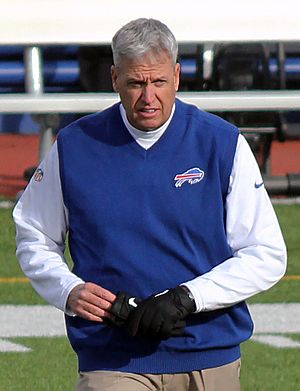
The 2015 season was the first full season under the Pegula family's ownership. Coach Doug Marrone left, and Rex Ryan, who had been fired by the New York Jets, became the new head coach. The team changed its offense, bringing in new players like quarterback Tyrod Taylor and running back LeSean McCoy.
The Bills set a record for season ticket sales in 2015. They finished 8–8, missing the playoffs for the 16th straight season. In 2016, Kathryn Smith became the first woman to be a full-time coach in the NFL, hired by the Bills as a special teams quality control coach.
The 2016 season was affected by injuries to top draft picks. Rex Ryan was fired in December 2016 after a 15–16 record in two seasons. The Bills finished 7–9.
The McDermott / Allen Era (2017-Present)
First Playoff Berth in Years (2017)
On January 11, 2017, Sean McDermott was hired as the Bills' new head coach. Brandon Beane became the general manager. Many players from the previous era were traded away. McDermott often used the phrase "Trust the Process" when asked about rebuilding the team. Fans started calling the duo "McBeane."
Despite low expectations, the Bills played surprisingly well. On December 31, 2017, the Bills made the playoffs for the first time in 17 seasons! They won their game against the Miami Dolphins, and another game went their way. Their season ended on January 7, 2018, with a 10–3 loss to the Jacksonville Jaguars in the Wild Card game.
Josh Allen Arrives (2018)
In the offseason, the Bills made more changes. They traded Tyrod Taylor and drafted Josh Allen to compete for the starting quarterback job. On May 1, Kim Pegula became the team president.
Nathan Peterman started the first game of 2018 but struggled. Josh Allen took over as the starter from Week 2 onward. The Bills finished the 2018 season 6–10. Their offense was weak early on, but their defense was strong.
Notable games included a big win over the favored Minnesota Vikings and a revenge win against the Jacksonville Jaguars. 2018 was also the final season for longtime defensive tackle Kyle Williams, who was considered the "heart and soul" of the team.
More Playoff Appearances (2019-2021)
Before the 2019 season, the Bills added many offensive players like receivers John Brown and Cole Beasley. They also drafted defensive tackle Ed Oliver. The Bills clinched their second playoff spot in three years with a win over the Pittsburgh Steelers. They finished with 10 wins, their first time reaching that mark in the 21st century. However, they lost to the Houston Texans 22–19 in overtime in the Wild Card round.
In 2020, the Bills traded for star receiver Stefon Diggs. Josh Allen had a breakout year, and the Bills' passing game was very strong. Despite two mid-season losses, the Bills won nine of their next ten games. They clinched their first AFC East division title since 1995. The Bills finished with 13 wins, tying a franchise record. They also swept their entire division for the first time.
As the second seed in the AFC, the Bills hosted their first home playoff game in 24 years. They beat the Indianapolis Colts 27–24, their first playoff win in 25 years. The Bills then defeated the Baltimore Ravens 17–3 to reach the AFC Championship game. They faced the Kansas City Chiefs again but lost 38–24.
In 2021, Josh Allen signed a big contract extension. The Bills drafted defensive linemen Gregory Rousseau and Carlos "Boogie" Basham. After a slow start, the Bills won four straight games, including a victory over the Chiefs. They finished the season with another 4-game winning streak, clinching their second straight AFC East title. Buffalo also had the league's top defense.
The Bills hosted the New England Patriots in the Wild Card round, winning 47–17. They scored a touchdown on every offensive possession except for the final kneel-downs, a first in NFL history. They faced Kansas City again in the Divisional Round. In one of the greatest playoff games in recent NFL history, the Chiefs won 42–36 in overtime.
Recent Seasons (2022-2023)
In 2022, the Bills signed All-Pro pass rusher Von Miller. They were hyped as "Super Bowl favorites" and tied a franchise record with 13 wins, winning their third straight AFC East title. However, the season was emotionally tough due to events like the 2022 Buffalo shooting, blizzards, and medical emergencies involving co-owner Kim Pegula and safety Damar Hamlin.
Damar Hamlin's Injury
On January 2, 2023, Bills safety Damar Hamlin collapsed after a tackle during a game against the Cincinnati Bengals. Medical staff quickly performed CPR on the field. He was taken to the hospital in critical condition but was discharged nine days later. The game was postponed and later declared a No Contest by the NFL. Hamlin's serious injury drew national attention, and after much recovery, he was cleared to play the next season.
In 2023, the Bills started the season with a loss to the Jets. After winning three games, they went through a tough six-game slump. Offensive coordinator Ken Dorsey was fired and replaced by Joe Brady. The team rallied, winning six of their final seven games, including a Week 18 game against the Dolphins to win their fourth straight division title. After beating the Pittsburgh Steelers in the Wild Card game, Buffalo lost another Divisional Round game to the Chiefs. Kicker Tyler Bass's potential game-tying field goal attempt missed wide right, similar to Scott Norwood's famous miss in Super Bowl XXV.
Future Stadium Plans
On December 21, 2012, the Bills, New York Governor Andrew Cuomo, and Erie County Executive Mark Poloncarz announced a new 10-year lease for Ralph Wilson Stadium. This included money for renovations. The deal also called for exploring building a new stadium. In 2019, the Pegulas began pursuing this new stadium.
After reaching a deal with New York State and Erie County in 2022, construction began on a new stadium next to the current one. It is expected to be finished before the 2026 season.


